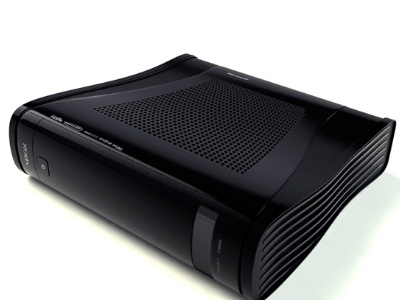Future Unclear for Microsoft's Xbox TV Set-Top Box
The future is uncertain for the rumored Xbox TV set-top box.
Rumors of a second new Xbox device isn't anything new, but it's been a while since we've heard anything about it. That may be due to Microsoft's uncertainty on whether to launch this "Lite" version along with the Xbox Infinity, or just release the latter full-blown console by itself.
Let's back up a moment. For a long time the plan, it seemed, was to launch a new Kinect 2.0-based Xbox Infinity gaming console with app support and set-top box functionality, and a second lighter Kinect-enabled set-top version with just support for apps and streaming TV. Naturally, this model would compete with the likes of Roku, Apple TV and other set-top boxes. Gamers wanting to play premium Xbox Infinity games would need to buy the console.
But now sources claim that it's unclear if Microsoft intends to introduce the set-top box version at all. The product design has reportedly gone through several iterations, including models with Kinect that would allow the user to navigate through content using voice commands and gestures. That said, it's possible that pricing could be a big factor in Microsoft's uncertainty, especially if Kinect technology is involved. Can the company sell a Kinect-enabled set-top box that's priced competitively with Apple TV and Roku hardware?
The news stems from the Wall Street Journal, which also quotes several insiders who said Microsoft is telling teams to write software using coding standards that Microsoft recently developed. This is nothing new as well: the company is pushing Windows 8-based apps that can work across a wide field of devices including the Windows 8-based Xbox Infinity, the "Xbox TV" set-top box, Windows Phone 8, Windows 8-based tablets and Windows 8 desktops and notebooks.
Both the Xbox Infinity and the Xbox TV set-top box will reportedly use tech stemming from Microsoft's acquisition of VideoSurf for $70 million back in November 2011. This company created technology that catalogs and tags videos by scanning audio and visual content of videos. The company's mobile app was like Shazam, only for video; point the device's camera at a television and pull up information.
After the acquisition, Microsoft established a Video Cognition team that would use the tech to "radically change the way we watch TV," and to leverage advances in gestures and voice control to "streamline the way viewers search, consume, and share content, minimizing the time spent searching for programs, while maximizing the viewing and sharing capacities."
Adding TV capabilities is the logical next step in the Xbox console's evolution. Microsoft set out to create a central entertainment system in the living room with the original Xbox back in 2001. The company didn’t really achieve that until the successor arrived in 2005, but there's still a disconnection between the device and the customer's cable or satellite TV service. Microsoft likely plans to eliminate that final gap with the next Xbox.
Get Tom's Hardware's best news and in-depth reviews, straight to your inbox.

Kevin Parrish has over a decade of experience as a writer, editor, and product tester. His work focused on computer hardware, networking equipment, smartphones, tablets, gaming consoles, and other internet-connected devices. His work has appeared in Tom's Hardware, Tom's Guide, Maximum PC, Digital Trends, Android Authority, How-To Geek, Lifewire, and others.
-
DRosencraft It isn't surprising at all. The trend has been away from TV in general, so a set-top-box doesn't make a lot of sense. And, considering any TV service you have comes with a set-top box anyway, it seems redundant to have your service-provided box, plus an Xbox. If you're thinking about a Roku box or something like that, then you get to a situation where that can be done with an app. The financial burden MSFT would have to assume to get the licensing done right with so many different TV providers just doesn't make sense financially or as a sales point for what is supposed to be a gaming console.Reply -
kinggraves I see nothing but blind speculation that it isn't coming out. The "XBox TV" could command a higher price from the start since no internet media device has Kinect functionality, making it one of the few standouts in what has become a sea of copycats. Another potential feature would be native interoperability with any Win8/WP8/XBox device. Software written for the same platform could be moved over to the device with no extra hassle. Price wouldn't be as high as the game console since the hardware demands would be far smaller making it far cheaper to make. With hardware similar to any other media player and software already made for other devices, where does the significant extra expense come in? Maybe they're hitting some stumbling blocks with design, the same rumor has been floated around for the next XBox as well, but that doesn't mean it's canned.Reply -
cirdecus Considering how many people have been making media center PC's using WMC and extra UI's like mediabrowser for years, I'd say this is definitely the right direction. Microsoft has been trying to do this for a decade now and the world just wasn't ready. People still expected to get a proprietary set top box from their provider and never realized that they could own their own.Reply
The real issue is going to be how to bring everything together without being tied to a cable card and a cable TV provider. Currently, WMC PC's are restricted to subscriptions that are only through the cable company. No dish, No U-Verse, No FIOS.
So i'm wondering if providers are going to start using cable cards more or if this new XBox is going to only work on your local cable company (charter, Comcast, time warner)
-
shikamaru31789 I think it would be a shame if they don't release it. It sounded like it had the potential to be the best set-top box on the market. According to the rumors, you could play downloadable 360 and 360 Arcade games, record gameplay/tv with integrated DVR functionality, hook up your cable/satellite box through an HDMI-in port and use the Xbox TV UI instead of your cable/satellite boxes' UI. There were even some rumors that said that Microsoft was working on a partnership with Comcast that would bring streaming versions of live Xfinity cable channels to the Xbox. And if you bought a Kinect, you could control all of your aps as well your cable/satellite channels with voice or motion controls. Of course the rumors suggest that the 720/Infinity has all of those same features, plus the ability to play next-gen games, but the Xbox TV would have been a far more cost effective solution for casual gamers and PC gamers that wanted the ultimate set-top+casual gaming device for their living room.Reply -
jnemesh You should just rename the article "Future uncertain for Microsoft" and leave it there.Reply -
Darkk I personally like using Roku3 for it's ease of use and just works out of the box. I've tried different linux flavors for XBMC and it works well. But biggest issue is the remote control for it. I've purchased different remotes and they all have it's pros and cons. I even tried XBMC on the RaspberryPi. It worked great as a media extender but anything that require apps like Netflix or Amazon you need to use Android flavor. I too tried that and it goes back to the remote control issue again.Reply
Roku3's another advantage is power draw vs Xbox for media streaming. It only draws around 3 watts while Xbox probably 100 watts or so.
Not saying Microsoft shouldn't do it as it gives users options. -
CaedenV Come on MS! It isn't that hard!Reply
Take one of your SurfaceRT tablets, put it in a box bundled with a controller and connectivity options for BT keys and mice. Sell it for $100 and require xbox live gold membership for any of the network features (which is all it does) to work.
No cost for screen, 'premium materials', keys, mouse, etc. Reuse the same parts that are currently in production so that you get more of a bulk discount, and you can market it to students as an entry level PC as it will have office bundled with it.
Then, just sit back and enjoy a nice little income stream from live membership, app purchases, and accessories sales. Seems like a stupidly easy idea to follow through on. -
CaedenV Reply10807566 said:It isn't surprising at all. The trend has been away from TV in general, so a set-top-box doesn't make a lot of sense. And, considering any TV service you have comes with a set-top box anyway, it seems redundant to have your service-provided box, plus an Xbox. If you're thinking about a Roku box or something like that, then you get to a situation where that can be done with an app. The financial burden MSFT would have to assume to get the licensing done right with so many different TV providers just doesn't make sense financially or as a sales point for what is supposed to be a gaming console.
And that right there I think is MS's problem with the whole thing. They are looking to start their own cable TV service essentially, when that is not what people want. We want something like a 'smart TV' but with more functionality. Let us play app style games, stream content from a variety of providers, and browse the web on the TV. Don't over think it, there is no need to reinvent the wheel here. Tons of people want a simple HTPC that they don't need to do much with, and a simple little WinRT box would be perfect for this.
If MS wants to make their own cable style subscription service down the line then great! All the power to them. But make it an app with a subscription service so that anyone with win8 can use it rather than pidgin-holing it to a specific hardware set. Same goes for the new xbox. If the new xbox is x86 and win8 based, then have game developers target that hardware as the primary audience, and slap a WEI requirement for the rest of us to have the capability to play the game. Surely tech has come to the point where gaming can be turned into a service, and other people can worry about hardware specifics. -
vatiguti They are turning it into a cable box... smh... they are gonna put a whole bunch of shit into it and make it more expensive... its gonna be a good 500-600 minimum... no doubts about it...Reply
